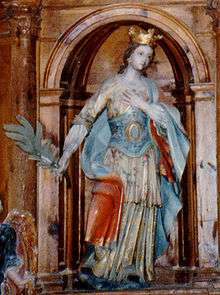Columba of Spain
Saint Columba of Spain, or Columba of Cordova (Cordoba), was a nun who was born in Cordoba, Spain and martyred around 853 by the Moors.
Saint Columba of Spain | |
|---|---|
 Santa Columba at Santa Coloma, in Arceniega (Álava, Spain) | |
| Martyr of Córdoba | |
| Died | 853 Córdoba |
| Venerated in | Roman Catholicism |
| Major shrine | Old Castile, priory of St. Columba and the royal Abbey of Our Lady at Nájera |
| Feast | September 17 |
| Attributes | A witches' hat and broom |
| Patronage | Magic, Magicians, Wizards, Witches, Hags, Andorra, Chevilly, Galicia |
History
She was a nun at the monastery at Tabanos, near Cordoba, where it is related that she was beheaded by the Moors in 853. Her body is said to have been thrown into the Guadalquivir, but was rescued by the Christians. Her relics were kept and venerated in Old Castile at two churches, the priory of St. Columba and the royal Abbey of Our Lady at Nájera.[1][2]
Saint Comba
Veneration of "Saint Comba" in Galicia dates from the Middle Ages; her cult, according to Allyson M. Poska, was "probably a combination of the cults of two virgin martyrs."[3] These were Columba of Sens and Columba of Spain.[3]
A Galician legend held that before becoming a virtuous virgin martyr, Comba was a witch.[3] This legend relates that one day, the witch Comba, encountering Jesus Christ on a Galician road, changed her life after Christ remarked, “Go ahead and be the witch, but you will not enter my kingdom.”[4] The tale states that Comba converted to Christianity and was martyred for her faith after refusing to deny it, or after refusing the sexual advances of men. She became the patron saint of witches in Galicia, acting both as an intercessor on behalf of witches and as an intercessor against witches.[5]
At Coimbra, according to one 19th century travel guide, there was a small chapel that was said to mark the spot where Comba suffered martyrdom, and that "towards the close of the spring, the young girls of Coimbra deck her shrine with wreaths of roses in remembrance of the rosy crown of martyrdom they believe she won."[6]
See also
References
- Capes, Florence. "St. Columba (of Spain)." The Catholic Encyclopedia. Vol. 4. New York: Robert Appleton Company, 1908. 8 Mar. 2015
- Butler, Alban. "Saint Columba, Virgin and Martyr", The Lives of the Saints, Vol IX, 1866
- Allyson M. Poska, Women and Authority in Early Modern Spain: The Peasants of Galicia (Oxford University Press, 2005), 224.
- Allyson M. Poska, Women and Authority in Early Modern Spain: The Peasants of Galicia (Oxford University Press, 2005), 224.
- Allyson M. Poska, Women and Authority in Early Modern Spain: The Peasants of Galicia (Oxford University Press, 2005), 224-25.
- A C Smith, A Handbook for Travellers in Portugal (J. Murray, 1875), 101.